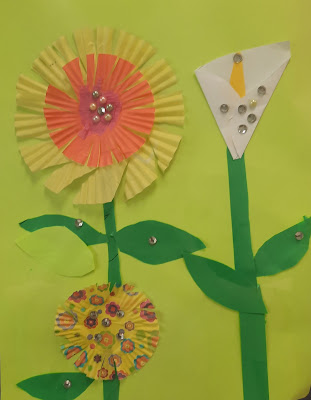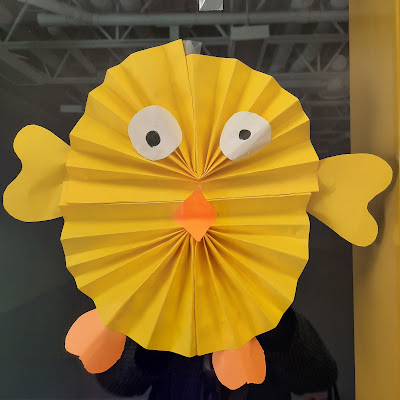
This project was designed by a very creative English teacher at my school. We've taught together at two different schools! You know when you meet that teacher that you collaborate so naturally with? Well, that's her! We have done many English + Art lesson collaborations over the years.
See our found poetry based on the novel "The Book Thief"
HERE.
See our blackout poetry lesson
HERE.
For this visual poetry lesson, teachers were asked to email us a scan of a favourite page/passage from their favourite book. As you can imagine, we received a wide variety of texts, from fiction to non-fiction.
We printed all of these out and the English teacher wrote a basic synopsis for each book. Grade 7-9 students were then given this list and chose which book they were going to illustrate. They did not know which teacher had submitted the page, nor the name of the book.
Students had the choice of creating either a Found Poem or a Blackout Poem. They also had to include their own title of their poem. They could use any media they wanted.
Found poems essentially take existing texts and refashion them, reorder them, and present them as poems. They are the literary equivalent of a collage. One can take words, phrases, and sometimes whole passages from other sources and reframe them as poetry by making changes in spacing and lines, or by adding or deleting text, thus imparting new meaning.
A blackout poem is when a poet takes a marker (usually a black marker) to already established text--like in a newspaper or book page--and starts redacting words until a poem is formed. The key thing with a blackout poem is that the text AND blocked out text form a sort of visual poem.
Below is the page I submitted- "The English Patient" is a 1992 novel by Canadian Michael Ondaatje.
It is a stunning, poetic and challenging book to read and the movie is also one of my all time favourites!
A synopsis for this book would read something like this:
With ravishing beauty and unsettling intelligence, Michael Ondaatje's Booker Prize-winning novel traces the intersection of four damaged lives in an Italian villa at the end of World War II. Hana, the exhausted nurse; the maimed thief, Caravaggio; the wary sapper, Kip: each is haunted by the riddle of the English patient, the nameless, burned man who lies in an upstairs room and whose memories of passion, betrayal, and rescue illuminates this book like flashes of heat lightening.
This is the found poem that a student created based on this page. She printed out phrases she liked, then created an artwork around it (sharpies and watercolour).
Some other finished poems; the book is labelled under each photo.
Some of them I forgot unfortunately as this project is from 2 years ago.
 |
The Handmaid's Tale is a futuristic dystopian novel by
Canadian author Margaret Atwood published in 1985. The novel explores themes of subjugated women in a patriarchal society, loss of female agency and individuality, suppression of women's reproductive rights, and the various means by which women resist and try to gain individuality and independence.
The Handmaid's Tale won the 1985 Governor General's Award and the first Arthur C. Clarke Award in 1987; it was also nominated for the 1986 Nebula Award, the 1986 Booker Prize, and the 1987 Prometheus Award. |
Below is the display I created. I added the book title along with the names of the student artist and teacher.
 |
The Pleasure of Finding Things Out by American physicist Richard Feynman. It is a collection of short works, including interviews, speeches, lectures, and printed articles.
|

|
All the Light We Cannot See is a 2014 war novel that was written by American author Anthony Doerr. The novel is set during World War II and centers around the characters Marie-Laure Leblanc, a blind French girl who takes refuge in her uncle's house in Saint-Malo after Paris is invaded by Nazi Germany; and Werner Pfennig, a bright German boy who is accepted into a military school because of his skills in radio technology before being sent to the military.
It won the 2015 Pulitzer Prize for Fiction. |
 |
The Grapes of Wrath is an American realist novel written by John Steinbeck and published in 1939. The book won the National Book Award and Pulitzer Prize for fiction, and it was cited prominently when Steinbeck was awarded the Nobel Prize in 1962.
Set during the Great Depression, the novel focuses on the Joads, a poor family of tenant farmers driven from their Oklahoma home by drought, economic hardship, agricultural industry changes, and bank foreclosures forcing tenant farmers out of work. |
 |
The Hunger Games is a 2008 dystopian novel by the American writer Suzanne Collins. It is written in the perspective of 16-year-old Katniss Everdeen, who lives in the future, post-apocalyptic nation of Panem in North America. |
 |
Pride and Prejudice is an 1813 novel by Jane Austen. The novel follows the character development of Elizabeth Bennet, the protagonist of the book, who learns about the repercussions of hasty judgments and comes to appreciate the difference between superficial goodness and actual goodness.
Pride and Prejudice has consistently appeared near the top of lists of "most-loved books" among literary scholars and the reading public. It has become one of the most popular novels in English literature, with over 20 million copies sold |
Here are some of the blackout poems:
 |
Americanah is a 2013 novel by the Nigerian author Chimamanda Ngozi Adichie, for which Adichie won the 2013 U.S. National Book Critics Circle Award for fiction. It tells the story of a young Nigerian woman, Ifemelu, who immigrates to the United States to attend university. The novel traces Ifemelu's life in both countries, threaded by her love story with high school classmate Obinze.
Americanization is one of the most prominent themes in Americanah. In the context of the novel, America itself is a symbol of hope, wealth, social and economic mobility, and, ultimately, disappointment, as Ifemelu learns that the American Dream is a lie and that the advantages she enjoys there often come at a great price. |
 |
| Flatterland is a 2001 book written by British mathematician and science popularizer Ian Stewart about non-Euclidean geometry. |
 |
| A Scientific Romance by Canadian travel writer Ronald Wright, 1998. Wright has fashioned a story for our times, an unforgettable chronicle of love, plague and time travel. Building on H.G. Wells' novel, The Time Machine, Wright portrays a dystopian future, into which an individual, by scientific miracle, travels 500 years, documenting every emotion and experience. |
 |
| The Guns of August (1962) is a volume of history by American Barbara W. Tuchman. It is centered on the first month of World War I. The book was awarded the Pulitzer Prize for General Non-Fiction for publication year 1963. |














.png)
































































